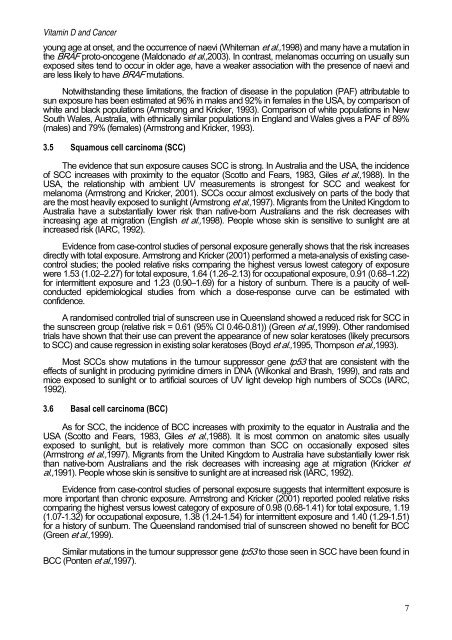Create successful ePaper yourself
Turn your PDF publications into a flip-book with our unique Google optimized e-Paper software.
Vitamin D and Cancer<br />
young age at onset, and the occurrence of naevi (Whiteman et al.,1998) and many have a mutation in<br />
the BRAF proto-oncogene (Maldonado et al.,2003). In contrast, melanomas occurring on usually sun<br />
exposed sites tend to occur in older age, have a weaker association with the presence of naevi and<br />
are less likely to have BRAF mutations.<br />
Notwithstanding these limitations, the fraction of disease in the population (PAF) attributable to<br />
sun exposure has been estimated at 96% in males and 92% in females in the USA, by comparison of<br />
white and black populations (Armstrong and Kricker, 1993). Comparison of white populations in New<br />
South Wales, Australia, with ethnically similar populations in England and Wales gives a PAF of 89%<br />
(males) and 79% (females) (Armstrong and Kricker, 1993).<br />
3.5 Squamous cell carcinoma (SCC)<br />
The evidence that sun exposure causes SCC is strong. In Australia and the USA, the incidence<br />
of SCC increases with proximity to the equator (Scotto and Fears, 1983, Giles et al.,1988). In the<br />
USA, the relationship with ambient UV measurements is strongest for SCC and weakest for<br />
melanoma (Armstrong and Kricker, 2001). SCCs occur almost exclusively on parts of the body that<br />
are the most heavily exposed to sunlight (Armstrong et al.,1997). Migrants from the United Kingdom to<br />
Australia have a substantially lower risk than native-born Australians and the risk decreases with<br />
increasing age at migration (English et al.,1998). People whose skin is sensitive to sunlight are at<br />
increased risk (<strong>IARC</strong>, 1992).<br />
Evidence from case-control studies of personal exposure generally shows that the risk increases<br />
directly with total exposure. Armstrong and Kricker (2001) performed a meta-analysis of existing casecontrol<br />
studies; the pooled relative risks comparing the highest versus lowest category of exposure<br />
were 1.53 (1.02–2.27) for total exposure, 1.64 (1.26–2.13) for occupational exposure, 0.91 (0.68–1.22)<br />
for intermittent exposure and 1.23 (0.90–1.69) for a history of sunburn. There is a paucity of wellconducted<br />
epidemiological studies from which a dose-response curve can be estimated with<br />
confidence.<br />
A randomised controlled trial of sunscreen use in Queensland showed a reduced risk for SCC in<br />
the sunscreen group (relative risk = 0.61 (95% CI 0.46-0.81)) (Green et al.,1999). Other randomised<br />
trials have shown that their use can prevent the appearance of new solar keratoses (likely precursors<br />
to SCC) and cause regression in existing solar keratoses (Boyd et al.,1995, Thompson et al.,1993).<br />
Most SCCs show mutations in the tumour suppressor gene tp53 that are consistent with the<br />
effects of sunlight in producing pyrimidine dimers in DNA (Wikonkal and Brash, 1999), and rats and<br />
mice exposed to sunlight or to artificial sources of UV light develop high numbers of SCCs (<strong>IARC</strong>,<br />
1992).<br />
3.6 Basal cell carcinoma (BCC)<br />
As for SCC, the incidence of BCC increases with proximity to the equator in Australia and the<br />
USA (Scotto and Fears, 1983, Giles et al.,1988). It is most common on anatomic sites usually<br />
exposed to sunlight, but is relatively more common than SCC on occasionally exposed sites<br />
(Armstrong et al.,1997). Migrants from the United Kingdom to Australia have substantially lower risk<br />
than native-born Australians and the risk decreases with increasing age at migration (Kricker et<br />
al.,1991). People whose skin is sensitive to sunlight are at increased risk (<strong>IARC</strong>, 1992).<br />
Evidence from case-control studies of personal exposure suggests that intermittent exposure is<br />
more important than chronic exposure. Armstrong and Kricker (2001) reported pooled relative risks<br />
comparing the highest versus lowest category of exposure of 0.98 (0.68-1.41) for total exposure, 1.19<br />
(1.07-1.32) for occupational exposure, 1.38 (1.24-1.54) for intermittent exposure and 1.40 (1.29-1.51)<br />
for a history of sunburn. The Queensland randomised trial of sunscreen showed no benefit for BCC<br />
(Green et al.,1999).<br />
Similar mutations in the tumour suppressor gene tp53 to those seen in SCC have been found in<br />
BCC (Ponten et al.,1997).<br />
7

















